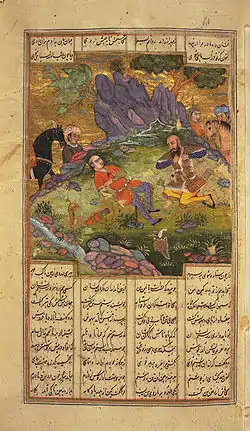Sohrab A heroic of Iranian myths and legends | |
|---|---|
| سهراب | |
.png.webp) Sohrab in Shahnameh of Shah Tahmasp | |
| Born | |
| Died | |
| Cause of death | Killed in combat by his father, Rostam, with neither Rostam nor Sohrab aware of their kinship. |
| Known for | Battle with Rostam |
| Children | Borzu (in Borzu Nama) |
| Parents | |
| Family | Zal (grandfather)Zavara (uncle) |

Sohrāb or Suhrāb (Persian: سهراب) is a legendary warrior from the Shahnameh, or the Tales of Kings by Ferdowsi in the tragedy of Rostam and Sohrab.[1] He was the son of Rostam, who was an Iranian warrior, and Tahmineh, the daughter of the king of Kingdom of Samangan, a neighboring country. He was slain at a young age by his father Rostam. Rostam only found out he was his son after fatally wounding him in a duel. Kaykavous, the king of Iran, delayed giving Rostam the panacea (Noush Daru) to save Sohrab as he feared losing his power to the alliance of the father and the son. Rostam gave Tahmineh a bracelet as a reminder and a sign to his son.
His name means “hot red water”, and is analogous with the modern Persian term, "Sorkh-ab".[2] It can also mean "beautiful and illustrious/shining face". The name Sohrab is associated with tremendous bravery and courage.
Family tree
| Nariman | |||||||||||||||||||||||||||||||||||||||||||||
| Sām | Mehrab Kaboli | Sindukht | |||||||||||||||||||||||||||||||||||||||||||
| Zāl | Rudaabeh | ||||||||||||||||||||||||||||||||||||||||||||
| Rostam | Tahmineh | ||||||||||||||||||||||||||||||||||||||||||||
| Sohrab | |||||||||||||||||||||||||||||||||||||||||||||
See also
- Rostam and Sohrab – Opera by Loris Tjeknavorian
- Sohrab and Rustum – 1853 narrative poem by Matthew Arnold
- Zurab – Georgian masculine given name
References
- ↑ Seyed-Gohrab, Asghar (2015-05-04). "Corrections and Elaborations: A One-Night Stand in Narrations of Ferdowsi's Rostam and Sohrāb". Iranian Studies. 48 (3): 443–461. doi:10.1080/00210862.2014.1000618. ISSN 0021-0862. S2CID 145637218.
- ↑ Ghazarian, Lusiné (2006). "Review of Les kurdes Ardalân entre la Perse et l'Empire ottoman". Iran & the Caucasus. 10 (2): 312–314. doi:10.1163/157338406780345907. ISSN 1609-8498. JSTOR 4030935.
External links


.png.webp)